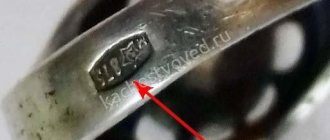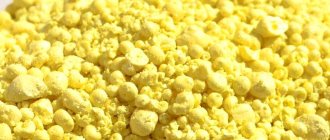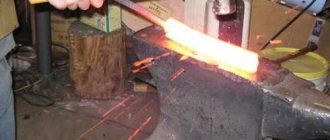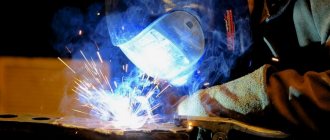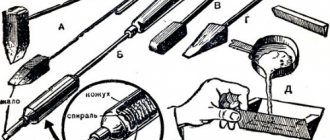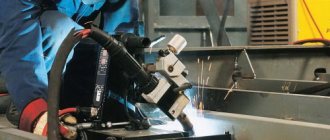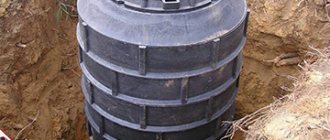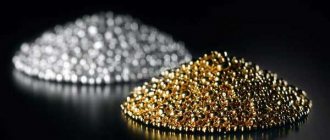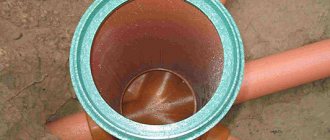Silver oxidation technology
Jewelry made from oxidized silver fades less and is corrosion resistant. The explanation is simple - during processing, the surface of the products is covered with a durable sulfide and oxide film.
At industrial enterprises, in handicraft workshops and at home, oxidized silver is produced in two ways:
- chemical;
- electrolytic.
To create a colored decorative coating, electrolytes and solutions containing potassium chromate are used.
Chemical oxidation technology of silver
Silver products are chemically dyed in 10-15 minutes. The final shade depends on the exposure time, temperature and composition of the working solution. Its main component is sulfur liver , it is obtained in 15-20 minutes by fusing two ingredients in an iron cup: 1 part sulfur (S), 1-2 parts dry potash - soda ash (K₂CO₂).
Compositions for oxidation are prepared in several ways:
- first option - water, sulfur liver;
- second option - water, liver sulfur, ammonium carbonate;
- the third option is water, liver sulfur, ammonium chloride.
The solution is heated to 60−70 ℃, pre-skimmed decoration is dipped into it, adjusting the processing time, an oxide film of the desired color is obtained. If the composition is prepared using the first method, then its shades vary from light gray to black, the second - from gray-blue to black with blue, the third - from light gray to dark blue.
Having received the desired color, the decoration is removed from the solution, washed in water, and allowed to dry. Then, using pumice powder, chalk, cloth , the surface is cleaned. At the last stage, a beautiful gloss is applied with a soft brass brush.
Electrochemical oxidation
This technological process at a current density of 0.1−0.5 A/dm² and a temperature of 25 ℃ lasts 1−5 minutes, during which the jewelry is immersed in an electrolyte solution:
- sodium sulfide - 20−30 g/l;
- sodium sulfate - 15−20 g/l;
- sulfuric acid - 5−10 g/l;
- acetone - 3−5 g/l.
The color of the film is black and blue, drying time at a temperature of 60−70 ℃ is 5−10 minutes.
Pros and cons of oxidized silver
After polishing, the convex zones become lighter and the pattern becomes voluminous. Inserts made of natural stones look richer against the background of aged silver. The oxide film protects the surface from small mechanical decorations and creates bright accents.
The decorative film wears off over time and is restored by repeated oxidation.
Jewelers more often use the technology of chemically creating an oxide film. It is more economical and allows you to create different shades by changing the exposure time and solution temperature.
How does oxidation take place?
The process of processing silver jewelry takes place according to the following scheme:
- the product is placed in a pre-prepared solution;
- observe the chemical reaction;
- using a wooden device, the decoration is removed;
- wash the product in water.
To prepare the solution, sulfur liver is used - this is a solution of potassium carbonate and potassium sulfide in a percentage ratio of one to one or one to two. The components are dissolved in water, and then the solution is subjected to heat treatment - it is slowly heated to a temperature of 80-90 degrees.
If you want to give a tint to a separate area of silver jewelry, then the solution is applied selectively to individual areas of the jewelry.
If it is necessary to completely change the color of the jewelry, then it is completely immersed in the solution, and then washed under a stream of water, slowly reducing its temperature in order to fix the resulting color.
Before the procedure, silver must be degreased, and only then begin oxidizing the metal. For degreasing, you can use gasoline or alcohol.
When the silver processing process is completed, the surface of the jewelry is cleaned with felt cloth and first rubbed with chalk. The jewelry is polished - this helps to preserve and fix the result.
In workshops, silver jewelry is oxidized using electrolytic deposition. The temperature of the solution used for processing is much lower - from 18 to 22 degrees. Processing time takes approximately 35 minutes. After processing, the decoration is dried at a temperature of 60-70 degrees.
Caring for oxidized silver jewelry
Rings, earrings, and bracelets without inserts require standard care. Add liquid soap to boiled water at room temperature - 1 tsp. a soap solution for 15-20 minutes , then rinsed and gently wiped with a soft cloth.
Products with inserts are cleaned in the same way, but the characteristics of precious and semi-precious stones are taken into account. To remove dirt from oxidized silver, do not use special jewelry wipes soaked in abrasive polishing agents or professional sterling silver cleaners.
The classic set for quickly cleaning rings, earrings, bracelets, and rings made of oxidized silver from dirt consists of two napkins:
- damp, soaked in soapy water – to remove dirt;
- dry – for gentle polishing.
For hygienic reasons, silver jewelry is cleaned regularly. Skin particles, cosmetics, household chemicals, and dust settle on the surface and can cause allergic rashes . Irritation and itching occur in areas where oxidized silver jewelry comes into contact with the skin.
Advantages and disadvantages
Silver jewelry darkens over time. This happens because they come into contact with hydrogen sulfide from the surrounding air. Oxidation allows you to slow down the process: a thin film prevents the silver from oxidizing. True, this defense cannot be called serious - over time, a reaction will still become inevitable.
Oxidation technology gives jewelry additional volume, depth and expressiveness. At the same time, it is safe, does not cause allergic reactions and costs almost nothing. Once the coating is damaged, it can be repaired in a workshop.
Blackening (patination) of copper
The process of oxidation of copper, as a result of which a copper product acquires a dark color, is called blackening or patination of copper.
| Patination is the process of formation of sulfur or chloride compounds on the surface of a metal as a result of the interaction of chemical elements with the metal. |
Blackening (patination) of copper is carried out in a solution of sulfur liver. As a result of the interaction of sulfur ions with metal, a film of copper sulfide is formed on the surface of a copper product - a black salt insoluble in water and non-concentrated acids.
The following solutions are used for blackening copper:
- liver sulfur (10-20 g/l) is brought to a boil;
- liver sulfur (6-10 g/l), ammonium chloride (40 g/l) at a temperature of 800C;
- caustic soda (9 g/l), ammonium persulfate (3 g/l) at a temperature of 1000C.
The oxidation reaction takes place quickly, the copper product acquires a dark, noble shade (antique). Copper coins are often patinated in this way - as a result, in the recesses the copper becomes black, on inclined surfaces the shade is lighter, and on convex surfaces the product retains a brilliant red color. The coinage is heated before being immersed in the solution.
Artistic patination of copper plates
In art workshops, for processing coinage and various jewelry made of copper, a method of oxidizing copper without immersion in a solution is often used. To do this, a layer of concentrated nitric acid is carefully applied to the surface of the product, after which the product is heated. The color of copper changes depending on temperature from greenish-blue to black. Then the product is cooled, washed with water and the convex parts of the composition are lightened using a thick cloth soaked in gasoline.
Another method of color oxidation of copper, in which different shades of the surface of the product are obtained in the same solution, is carried out in a mixture of sodium sulfate (130 g/l) and lead acetate (35 g/l) at a temperature of 800C. The surface of the product under the influence of the solution may acquire a yellow, orange, red or purple color. The shade of the oxide film constantly changes when rocking; when the desired result is achieved, the product is removed from the solution, dried and varnish is applied. At the same time, it is almost impossible to obtain two identical products; each artistic composition will be unique.
Removing oxide film from copper
Removal of the dark patination film from the surface of the product is carried out in a solution (10-15%) of acids - sulfuric and nitric.
Caution: When concentrated sulfuric and nitric acid are mixed, a reaction occurs that produces a large amount of heat. Only special thin-walled chemical containers should be used. When dissolving acids, pour the acid into the water slowly, in small portions. It should be remembered that copper salts are poisonous; all work should be carried out in a fume hood.
Patination and oxidation of brass products
Products made of brass are also subjected to oxidation in order to paint the surface or create artistic compositions in an antique style. On brass products, oxide films with many colors and shades are obtained - yellow, orange, red, blue, black, etc., and it is possible to obtain both a glossy and matte surface.
Blackening of brass
One of the methods for blackening brass is a method in which antimony chloride is applied to the surface of the product. The reagent is applied with a brush or roller, and then rubbed in with a thick cloth or brush. Depending on the concentration of the solution, shades from gray to black are obtained.
Obtaining colored oxide films on brass
Colored oxide films on brass are produced in several ways. The simplest is oxidation in a solution of nitric acid. A brass part immersed in a solution is coated with a layer of copper nitrate and painted green-blue. The process occurs with gradual heating. The color of the film changes during the heating process, and the process ends with the surface being painted black.
As an oxidation solution, you can use a regular photo printing fixer (sodium triosulfate or hyposulfite). A small amount of nitric acid is added to the fixer solution (40-60 g/l) (the solution is acidified). As a result, a chemical reaction occurs with the release of sulfur dioxide and the deposition of sulfur, and the solution becomes cloudy yellow or yellow-green. Prepare the solution immediately before processing brass; the solution is active for 15-20 minutes. The color changes with exposure time and has a bluish or purple tint. The container for the solution is selected so that the surface of the product is visible. The product is immersed in a container for a short time, then removed and washed in hot water. Then a layer of sand is applied to the surface of the product and wiped with a brush or thick cloth. The product acquires its final shade after repeated immersion in the solution. After removal from the solution, the surface is treated with pumice, erasing the dark coating, dried and covered with a layer of transparent varnish.
Another method of color oxidation of brass is carried out in a solution of sodium thiosulfate (130-150 g/l) and acetic or lead nitrate (35-40 g/l). The solution is heated to 80-900C. The process requires constant visual monitoring, because the color of the film changes quickly and continuously - yellow, red, purple, blue and, at the end of the process, black. When the desired shade is obtained, the product is quickly removed from the container, washed and dried.
For all of the listed methods of brass oxidation, the general rule is valid - the reaction can be stopped at any stage of the process; when the desired shade is obtained, the product is removed from the solution. If the product is preheated, the reaction can be interrupted by stopping the heating. The shade is fixed by simply rinsing the surface with water. Lightening of individual areas of the product is carried out with gasoline.
There are no exact recipes for preparing oxidation solutions and process modes; the results of artistic color oxidation depend on many factors - the purity of the initial components, the degree of heating of the part or solution, and the method of processing the product at the end of the process.
Most of the listed methods for oxidizing and patination of silver, copper or brass can be carried out at home or in a garage workshop, subject to basic safety rules that are valid for any process of applying electroplating or chemical coatings where concentrated acids are used or an active solution is heated to release gaseous substances.
You may be interested in the following articles:
|
